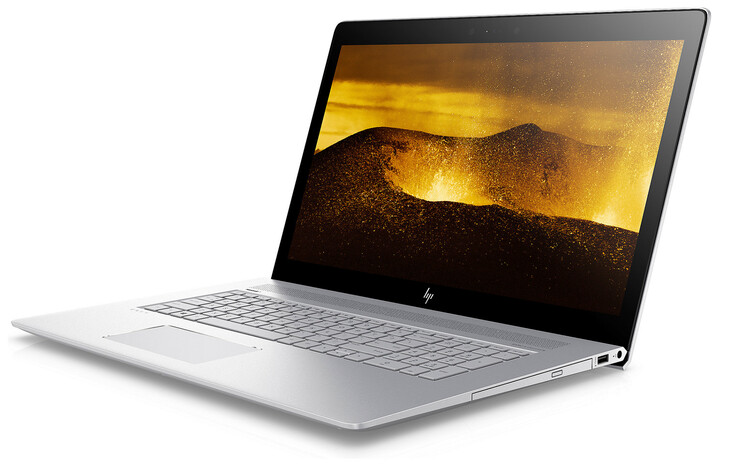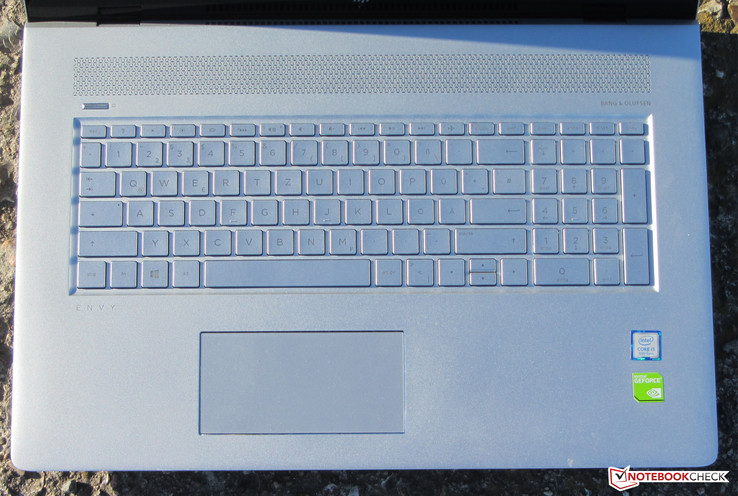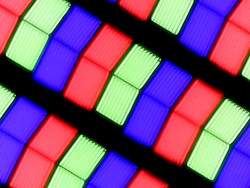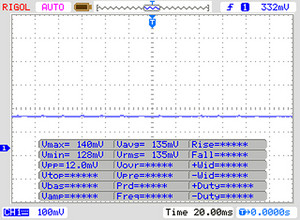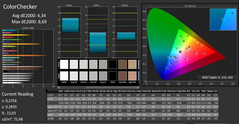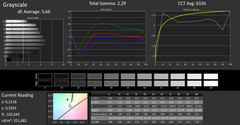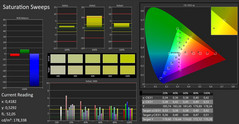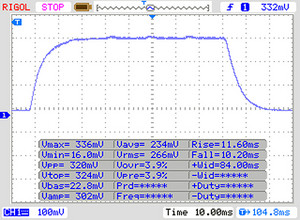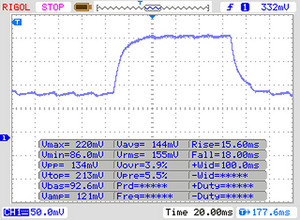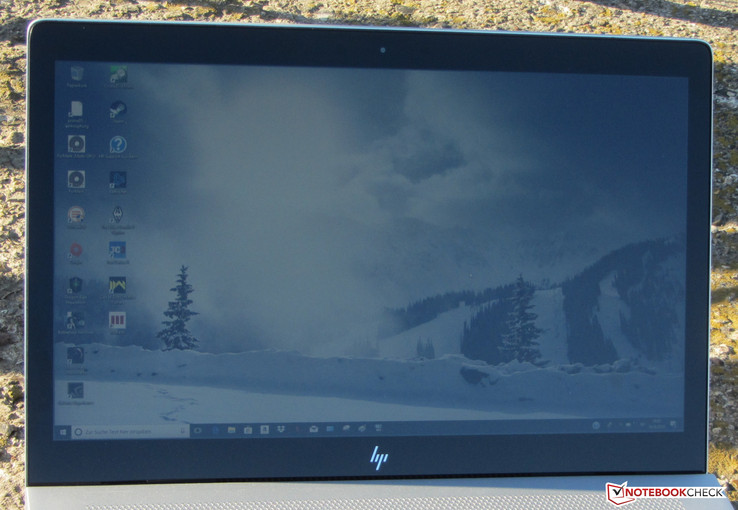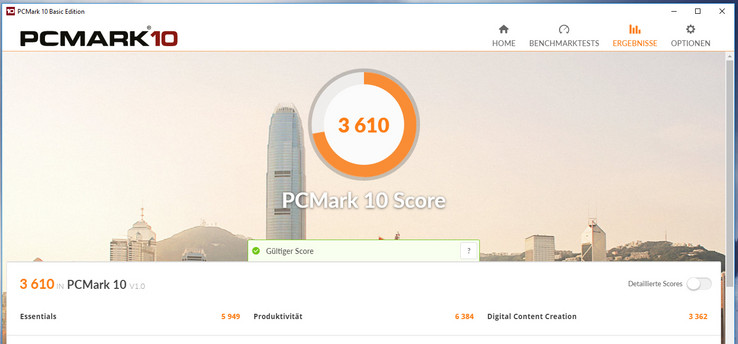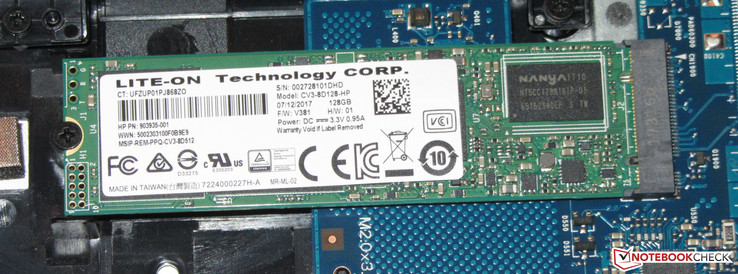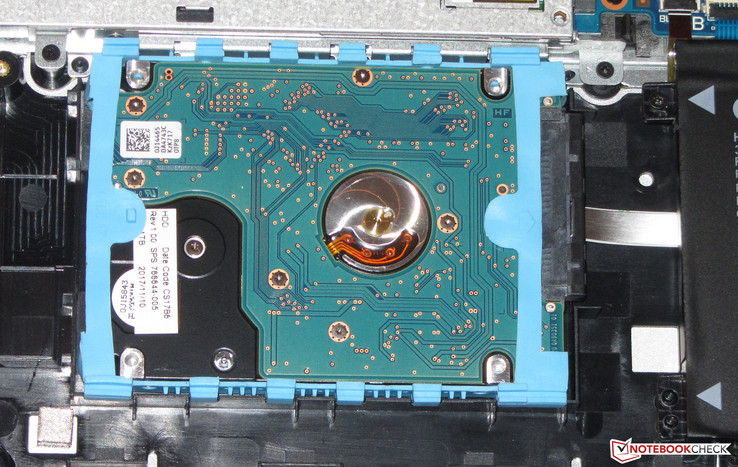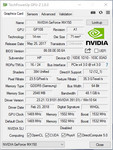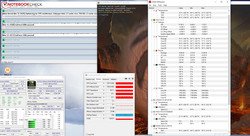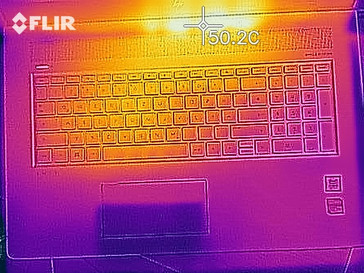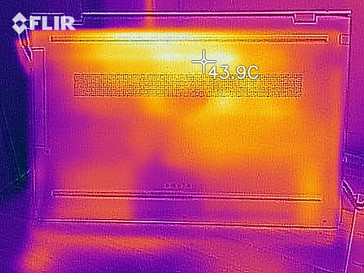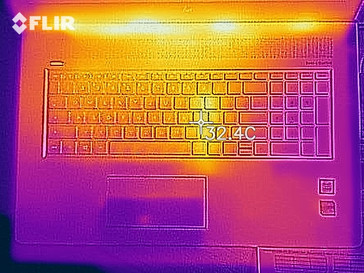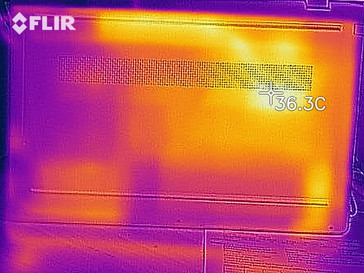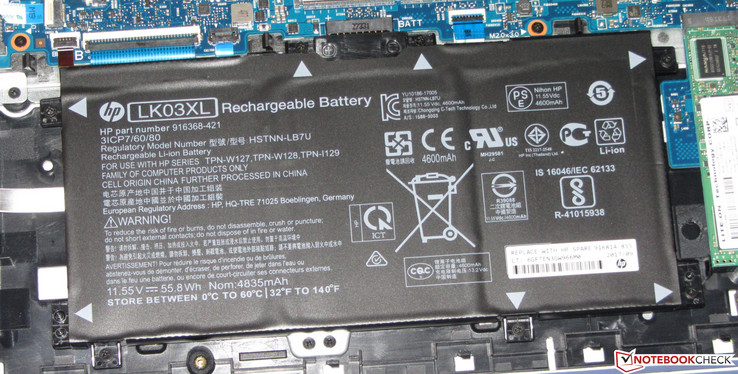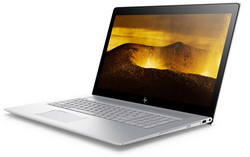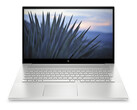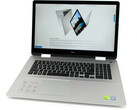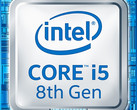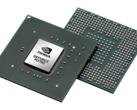HP Envy 17 (i5-8250U, MX150, SSD, FHD) Laptop Review

HP’s Envy 17 is a 17.3-inch multimedia notebook equipped with a ULV quad-core processor. It is somewhat gaming-capable thanks to its dedicated GeForce GPU. Its competitors are devices such as the Acer Aspire 5 A517-51G and the Asus VivoBook Pro 17 N705UD-EH76.
Case & Connectivity
The Envy 17’s case is made of aluminum. The device is clad entirely in silver save for the black display bezels. It is well made with narrow and consistent gaps and no overhangs to be found anywhere. That being said, the base unit’s rigidity leaves a lot to be desired as it is fairly bendy. The battery is not user-replaceable and the notebook lacks a dedicated maintenance flap.
Consequently, the device has to be taken apart in order to get to the internal hardware. First, the DVD drive needs to be opened to expose a tiny screw that needs to be removed. Afterwards, all other screws on the bottom have to be undone, including the three screws hidden behind the rear rubber strip. Once all the screws are removed, the bottom cover can be carefully popped open with a spudger tool or a spatula.
Connectivity and port availability were at the lower end of what we would have expected of a 17.3-inch notebook, and quite frankly we would have preferred at least one USB 3.1 Gen 2 USB Type-C port or even a Thunderbolt 3.0 port instead of four USB 3.1 Gen 1 ports (3x Type-A, 1x Type-C), especially when taking the notebook’s price into the equation. A single HDMI port for external displays is available.
The card reader is one of the faster candidates we have ever seen, and it managed transfer speeds of 82.9 MB/s when copying large chunks of data and 72.2 MB/s in our JPEG copy test (250 JPEG files at around 5 MB each) when benchmarked with our 64 GB Toshiba Exceria Pro SDXC UHS-II reference card.
HP opted for an Intel Dual Band Wireless-AC 7265 Wi-Fi chip with support for 802.11 a/b/g/n and, as the name suggests, ac. Transfer rates under ideal conditions (no other Wi-Fi devices nearby, close distance between notebook and server) were decent.
Connectivity
| SD Card Reader | |
| average JPG Copy Test (av. of 3 runs) | |
| Average of class Multimedia (21.1 - 198, n=40, last 2 years) | |
| Acer Aspire 5 A517-51G-80L (Toshiba Exceria Pro SDXC 64 GB UHS-II) | |
| HP Envy 17-ae143ng (Toshiba Exceria Pro SDXC 64 GB UHS-II) | |
| Asus VivoBook Pro 17 N705UD-EH76 (Toshiba Exceria Pro SDXC 64 GB UHS-II) | |
| maximum AS SSD Seq Read Test (1GB) | |
| Average of class Multimedia (27.4 - 262, n=40, last 2 years) | |
| Acer Aspire 5 A517-51G-80L (Toshiba Exceria Pro SDXC 64 GB UHS-II) | |
| HP Envy 17-ae143ng (Toshiba Exceria Pro SDXC 64 GB UHS-II) | |
| Asus VivoBook Pro 17 N705UD-EH76 (Toshiba Exceria Pro SDXC 64 GB UHS-II) | |
| Networking | |
| iperf3 transmit AX12 | |
| HP Envy 17-ae143ng | |
| Asus VivoBook Pro 17 N705UD-EH76 | |
| Acer Aspire 5 A517-51G-80L | |
| iperf3 receive AX12 | |
| Asus VivoBook Pro 17 N705UD-EH76 | |
| HP Envy 17-ae143ng | |
| Acer Aspire 5 A517-51G-80L | |
Input Devices
The Envy 17 is equipped with a backlit chiclet-style keyboard. The key caps are flat and smooth, and the keys offer a decent amount of travel, a very firm actuation point, and well-defined feedback. The keyboard flexed a little bit while typing, but this effect was mostly negligible. All things considered, the keyboard is pretty decent and has the potential to make prolific writers very happy.
The 12 x 6 cm multitouch-capable ClickPad is large enough for gesture input, and its smooth surface allowed for very accurate and comfortable input. The buttons’ travel is short but their feedback and actuation point are well-defined.
Display
| |||||||||||||||||||||||||
Brightness Distribution: 88 %
Center on Battery: 326 cd/m²
Contrast: 1135:1 (Black: 0.31 cd/m²)
ΔE ColorChecker Calman: 4.34 | ∀{0.5-29.43 Ø4.78}
ΔE Greyscale Calman: 5.66 | ∀{0.09-98 Ø5}
88% sRGB (Argyll 1.6.3 3D)
57% AdobeRGB 1998 (Argyll 1.6.3 3D)
64.3% AdobeRGB 1998 (Argyll 3D)
88% sRGB (Argyll 3D)
63.9% Display P3 (Argyll 3D)
Gamma: 2.29
CCT: 6326 K
| HP Envy 17-ae143ng IPS, 1920x1080, 17.3" | Asus VivoBook Pro 17 N705UD-EH76 IPS, 1920x1080, 17.3" | Acer Aspire 5 A517-51G-80L aSi TFT, IPS, 1920x1080, 17.3" | |
|---|---|---|---|
| Display | 1% | -1% | |
| Display P3 Coverage (%) | 63.9 | 67.9 6% | 66.3 4% |
| sRGB Coverage (%) | 88 | 86.8 -1% | 84.2 -4% |
| AdobeRGB 1998 Coverage (%) | 64.3 | 63.5 -1% | 61.6 -4% |
| Response Times | -2% | -36% | |
| Response Time Grey 50% / Grey 80% * (ms) | 33 ? | 30.8 ? 7% | 41 ? -24% |
| Response Time Black / White * (ms) | 21 ? | 23.2 ? -10% | 31 ? -48% |
| PWM Frequency (Hz) | 119000 ? | 122000 ? | |
| Screen | -3% | 10% | |
| Brightness middle (cd/m²) | 352 | 376.2 7% | 397 13% |
| Brightness (cd/m²) | 330 | 355 8% | 364 10% |
| Brightness Distribution (%) | 88 | 89 1% | 84 -5% |
| Black Level * (cd/m²) | 0.31 | 0.42 -35% | 0.29 6% |
| Contrast (:1) | 1135 | 896 -21% | 1369 21% |
| Colorchecker dE 2000 * | 4.34 | 4.21 3% | 3.88 11% |
| Colorchecker dE 2000 max. * | 8.69 | 8.31 4% | 8.22 5% |
| Greyscale dE 2000 * | 5.66 | 5.5 3% | 3.1 45% |
| Gamma | 2.29 96% | 2.335 94% | 2.59 85% |
| CCT | 6326 103% | 7056 92% | 6570 99% |
| Color Space (Percent of AdobeRGB 1998) (%) | 57 | 57 0% | 55 -4% |
| Color Space (Percent of sRGB) (%) | 88 | 87 -1% | 84 -5% |
| Colorchecker dE 2000 calibrated * | 3.95 | ||
| Total Average (Program / Settings) | -1% /
-2% | -9% /
1% |
* ... smaller is better
Screen Flickering / PWM (Pulse-Width Modulation)
| Screen flickering / PWM not detected | |||
In comparison: 53 % of all tested devices do not use PWM to dim the display. If PWM was detected, an average of 8108 (minimum: 5 - maximum: 343500) Hz was measured. | |||
Display Response Times
| ↔ Response Time Black to White | ||
|---|---|---|
| 21 ms ... rise ↗ and fall ↘ combined | ↗ 11 ms rise | |
| ↘ 10 ms fall | ||
| The screen shows good response rates in our tests, but may be too slow for competitive gamers. In comparison, all tested devices range from 0.1 (minimum) to 240 (maximum) ms. » 45 % of all devices are better. This means that the measured response time is similar to the average of all tested devices (20.2 ms). | ||
| ↔ Response Time 50% Grey to 80% Grey | ||
| 33 ms ... rise ↗ and fall ↘ combined | ↗ 15 ms rise | |
| ↘ 18 ms fall | ||
| The screen shows slow response rates in our tests and will be unsatisfactory for gamers. In comparison, all tested devices range from 0.165 (minimum) to 636 (maximum) ms. » 44 % of all devices are better. This means that the measured response time is similar to the average of all tested devices (31.6 ms). | ||
The 17.3-inch display features an IPS panel with wide viewing angles, which remains readable from all sides and directions. Brightness and contrast ratio are high enough to allow for outdoor usage. In theory, that is, because maximum brightness is reduced on battery and the reflective panel does everything in its power to add insult to injury.
Performance
The Envy 17 is an all-rounder multimedia notebook with a 17.3-inch display. It is powerful enough for most common usage scenarios and even allows for gaming thanks to its dedicated GPU. At the time of writing, our review unit was being sold for around 1,000 Euros (~$1235) in Europe. An identically configured model is not available in the US. Instead, the US base model features an i7-8550U and 16 GB of RAM, and sells for around $1,300 (model number: 2RX65AV_1).
Processor
Equipped with a Core i5-8250U Kaby Lake Refresh CPU, the Envy offers mid-range ULV quad-core power made by Intel. In theory, it should be more than fast enough for most users. The CPU runs at a base frequency of 1.6 GHz and is capable of turbo-boosting up to 3.4 GHz.
Our CPU multithread and single-thread benchmarks were performed between 3-3.3 GHz and 3-3.4 GHz, respectively. Occasionally, we witnessed individual CPU cores clocking down to 2.4-2.7 GHz. There were no differences between running the benchmarks when connected to mains and running them on battery.
Long-term sustained load capabilities are determined by running the Cinebench R15 multithread benchmark in a loop for around 30 minutes. Between the first and third iteration, the scores kept consistently dropping. They settled afterwards and remained consistent throughout the rest of the test. Thus, turbo boost was applied throughout the entire loop.
| JetStream 1.1 - Total Score | |
| Average of class Multimedia (482 - 711, n=2, last 2 years) | |
| Acer Aspire 5 A517-51G-80L (EDGE: 40.15063.674.0) | |
| MSI GS63VR 7RG-005 (Edge 41) | |
| Acer Nitro 5 AN515-51-788E (Edge 40) | |
| Asus VivoBook Pro 17 N705UD-EH76 (Microsoft Edge 41.16299.248.0) | |
| HP Envy 17-ae143ng (Edge 41) | |
| Average Intel Core i5-8250U (151.5 - 256, n=78) | |
System Performance
We found no fault with overall system performance, and the system ran very smoothly thanks to its SSD and the powerful i5 processor. PCMark scores were very high and hint at the notebook’s capabilities that go far beyond the usual office and Internet application requirements. The dedicated GPU even allows for some gaming. Further performance improvements are not possible; HP’s engineers already did everything they could to maximize performance.
| PCMark 8 Home Score Accelerated v2 | 3666 points | |
| PCMark 8 Creative Score Accelerated v2 | 4514 points | |
| PCMark 8 Work Score Accelerated v2 | 4882 points | |
| PCMark 10 Score | 3610 points | |
Help | ||
Storage Devices
The operating system resided on a 128 GB M.2-2280 SATA III SSD made by LiteOn, out of which 84 GB was user-accessible after first boot. The rest was taken up by the Windows operating system and the recovery partition. Transfer speeds were very good. HP does offer an optional NVMe SSD for the Envy 17 as well, which should be significantly faster thanks to its PCIe 3.0 x4 bus interface.
In addition to the aforementioned SSD, the notebook is also equipped with a regular 1 TB 7,200 RPM 2.5-inch hard disk drive.
| HP Envy 17-ae143ng Liteonit CV3-8D128 | Acer Aspire 5 A517-51G-80L Micron 1100 MTFDDAV256TBN | Average Liteonit CV3-8D128 | Average of class Multimedia | |
|---|---|---|---|---|
| CrystalDiskMark 3.0 | 42% | 2% | ||
| Read Seq (MB/s) | 457.9 | 480.1 5% | 450 ? -2% | |
| Write Seq (MB/s) | 167.7 | 385.6 130% | 238 ? 42% | |
| Read 512 (MB/s) | 222.2 | 295.6 33% | 267 ? 20% | |
| Write 512 (MB/s) | 156.8 | 302.5 93% | 167 ? 7% | |
| Read 4k (MB/s) | 26.91 | 27.58 2% | 23.3 ? -13% | |
| Write 4k (MB/s) | 60.3 | 81.4 35% | 55.9 ? -7% | |
| Read 4k QD32 (MB/s) | 299.5 | 247.4 -17% | 227 ? -24% | |
| Write 4k QD32 (MB/s) | 156.7 | 237.7 52% | 145.9 ? -7% |
GPU Performance
The featured GPU is a mid-range model by Nvidia. The GeForce MX150 supports DirectX 12, runs at speeds of up to 1,532 MHz, and it has access to 2 GB of GDDR5 RAM. 3DMark benchmark scores were at a level expected of this GPU.
| 3DMark 11 Performance | 4893 points | |
| 3DMark Ice Storm Standard Score | 72057 points | |
| 3DMark Cloud Gate Standard Score | 15047 points | |
| 3DMark Fire Strike Score | 3281 points | |
| 3DMark Fire Strike Extreme Score | 1662 points | |
| 3DMark Time Spy Score | 1195 points | |
Help | ||
| 3DMark 11 - 1280x720 Performance GPU | |
| Average of class Multimedia (3765 - 60002, n=58, last 2 years) | |
| Asus VivoBook Pro 17 N705UD-EH76 | |
| HP Envy 17-ae143ng | |
| Acer Aspire 5 A517-51G-80L | |
| Average NVIDIA GeForce MX150 (2796 - 4905, n=47) | |
| HP ProBook 470 G5 | |
| HP 17-bs103ng | |
Gaming Performance
Given its capabilities, the Envy 17 is able to run almost all current games smoothly. Granted, this does often necessitate a lower resolution (HD, or 1366x768) and reduced details (medium or low) but it will yield sufficient frame rates for an enjoyable gaming experience. Less-demanding games will obviously run just fine in higher resolutions and with more details while more-demanding games might require even further cutbacks of resolution and details. One such game would be Final Fantasy XV.
| low | med. | high | ultra | |
|---|---|---|---|---|
| World of Warcraft (2005) | 46.7 | |||
| StarCraft 2 (2010) | 252.4 | 130.5 | 107.6 | 60.5 |
| Diablo III (2012) | 176.5 | 159.9 | 140.3 | 88.8 |
| BioShock Infinite (2013) | 188.1 | 110.9 | 94.7 | 35 |
| Dragon Age: Inquisition (2014) | 113.1 | 74.5 | 26.4 | 17.9 |
| Battlefield Hardline (2015) | 79.3 | 78.1 | 43.6 | 28.5 |
| Call of Duty: Black Ops 3 (2015) | 97.8 | 48.6 | 28.7 | 27 |
| Just Cause 3 (2015) | 69.6 | 56.9 | 25.5 | 21.6 |
| Call of Duty Infinite Warfare (2016) | 67 | 60.7 | 33.2 | 29.8 |
| Watch Dogs 2 (2016) | 54.8 | 43.9 | 18.7 | 7.6 |
| Mass Effect Andromeda (2017) | 60.7 | 27.1 | 13 | 9.1 |
Emissions & Energy
System Noise
When idle, the Envy’s fan is quite often completely off. Nevertheless, the notebook is not completely soundless due to its spinning hard drive. At low revs, the fan was practically inaudible. Under load, the sound pressure level rose up to a very noticeable 39.7 dB(A). This level of system noise is acceptable considering the notebook's overall performance.
Unlike many other reviewed HP notebooks, the Envy does not have the “Fan always on” option in its BIOS setup.
Noise level
| Idle |
| 31.9 / 31.9 / 31.9 dB(A) |
| Load |
| 39.4 / 39.7 dB(A) |
 | ||
30 dB silent 40 dB(A) audible 50 dB(A) loud |
||
min: | ||
Temperature
Our stress test (Prime95 + FurMark running for at least a full hour) was completed identically on battery and on mains. During the first few minutes, the processor ran at speeds of 2.3-2.7 GHz and then started to slowly lower its frequency to between 1.7 and 2.3 GHz. Eventually it fluctuated between 1.2 and 1.8 GHz. The GPU ran at around 1500 MHz throughout the test.
By and large, the notebook remained comparatively cool. Even when running the stress test, surface temperatures remained below the 40 °C threshold all around the case.
(+) The maximum temperature on the upper side is 36 °C / 97 F, compared to the average of 36.9 °C / 98 F, ranging from 21.1 to 71 °C for the class Multimedia.
(+) The bottom heats up to a maximum of 37.6 °C / 100 F, compared to the average of 39.2 °C / 103 F
(+) In idle usage, the average temperature for the upper side is 25.1 °C / 77 F, compared to the device average of 31.3 °C / 88 F.
(+) The palmrests and touchpad are cooler than skin temperature with a maximum of 26 °C / 78.8 F and are therefore cool to the touch.
(+) The average temperature of the palmrest area of similar devices was 28.7 °C / 83.7 F (+2.7 °C / 4.9 F).
Speaker
The speakers made by Bang & Olufsen are located above the keyboard behind a perforated cover, and they were shockingly tinny and weak with a complete lack of bass. We would have expected much more from a self-proclaimed multimedia all-rounder. Thus, for an improved audio experience we suggest using headphones or external speakers instead.
HP Envy 17-ae143ng audio analysis
(±) | speaker loudness is average but good (73.1 dB)
Bass 100 - 315 Hz
(-) | nearly no bass - on average 29.6% lower than median
(±) | linearity of bass is average (8.2% delta to prev. frequency)
Mids 400 - 2000 Hz
(+) | balanced mids - only 4.6% away from median
(±) | linearity of mids is average (10.9% delta to prev. frequency)
Highs 2 - 16 kHz
(+) | balanced highs - only 3.8% away from median
(+) | highs are linear (4.5% delta to prev. frequency)
Overall 100 - 16.000 Hz
(±) | linearity of overall sound is average (24.9% difference to median)
Compared to same class
» 87% of all tested devices in this class were better, 5% similar, 8% worse
» The best had a delta of 5%, average was 17%, worst was 45%
Compared to all devices tested
» 75% of all tested devices were better, 5% similar, 19% worse
» The best had a delta of 4%, average was 24%, worst was 134%
Apple MacBook 12 (Early 2016) 1.1 GHz audio analysis
(+) | speakers can play relatively loud (83.6 dB)
Bass 100 - 315 Hz
(±) | reduced bass - on average 11.3% lower than median
(±) | linearity of bass is average (14.2% delta to prev. frequency)
Mids 400 - 2000 Hz
(+) | balanced mids - only 2.4% away from median
(+) | mids are linear (5.5% delta to prev. frequency)
Highs 2 - 16 kHz
(+) | balanced highs - only 2% away from median
(+) | highs are linear (4.5% delta to prev. frequency)
Overall 100 - 16.000 Hz
(+) | overall sound is linear (10.2% difference to median)
Compared to same class
» 7% of all tested devices in this class were better, 2% similar, 91% worse
» The best had a delta of 5%, average was 18%, worst was 53%
Compared to all devices tested
» 4% of all tested devices were better, 1% similar, 94% worse
» The best had a delta of 4%, average was 24%, worst was 134%
Frequency diagram (checkboxes selectable/deselectable!)
Power Consumption
Maximum power consumption when idle was measured at 10.3 W, which shot up to 86 W when running our stress test. Realistically, power consumption should vary between 40 and 80 W in everyday use cases. The power supply is rated at 90 W.
| Off / Standby | |
| Idle | |
| Load |
|
Key:
min: | |
Battery Life
In our real-life Wi-Fi test we simulate the load caused by loading various websites. During this test, the energy profile is set to “Balanced”, display brightness is normalized to 150 nits, and all energy-saving features are disabled. With these settings, the Envy ran for 8:07 hours.
| Battery Runtime - WiFi Websurfing | |
| Average of class Multimedia (4.37 - 19.6, n=65, last 2 years) | |
| HP Envy 17-ae143ng | |
| Acer Aspire 5 A517-51G-80L | |
| Asus VivoBook Pro 17 N705UD-EH76 | |
Pros
Cons
Verdict
All in all the Envy 17 made a decent impression. The i5 CPU is powerful enough for most common usage scenarios, and combined with the GeForce MX150 GPU it even allows for smooth gaming. While doing so, the notebook stayed comparatively cool and quiet.
Unlike many other notebooks equipped with one of Intel’s quad-core ULV processors, the Envy was able to maintain high turbo-boost speeds throughout our benchmark loops - a very positive and noteworthy quality. Accordingly, performance-wise the Envy 17’s 15 W Core i5-8250U was almost on a par with the 45 W Core i7-7700HQ.
The Hewlett Packard Envy 17 is a very decently equipped 17.3-inch multimedia all-rounder.
The system is very snappy thanks to its SSD, which can be upgraded to an NVMe model if necessary (or desired), and the additional 1 TB 2.5-inch HDD offers storage space aplenty. Both storage devices can be upgraded and replaced, but it requires removing the bottom cover and thus disassembling the case.
The backlit keyboard is of very good quality and is suitable for regular and sustained use. Battery life was pretty good, too, as were the display’s brightness and contrast ratio. Unfortunately, the display was reflective instead of matte.
There really isn’t much to criticize. Besides the glossy display the only other major fault was the thin and tinny speakers that are unworthy of a multimedia notebook. In addition, the notebook is only equipped with a USB 3.1 Gen 1 Type-C and no Thunderbolt 3.0 port, which should have been a given at the Envy’s price point.
HP Envy 17-ae143ng
- 03/18/2018 v6 (old)
Sascha Mölck




